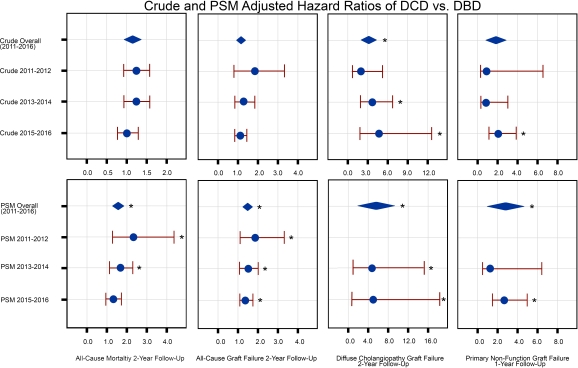Incidence Trends among Deceased Liver Transplant Recipients in the United States, 2011-2016: A Propensity Score-Matched Study
Transplant Institute, Henry Ford Hospital, Detroit, MI.
Meeting: 2018 American Transplant Congress
Abstract number: A263
Keywords: Donors, Graft failure, Liver transplantation, non-heart-beating, Survival
Session Information
Session Name: Poster Session A: Liver: MELD, Allocation and Donor Issues (DCD/ECD)
Session Type: Poster Session
Date: Saturday, June 2, 2018
Session Time: 5:30pm-7:30pm
 Presentation Time: 5:30pm-7:30pm
Presentation Time: 5:30pm-7:30pm
Location: Hall 4EF
Background
Donation after cardiac death (DCD) donor liver graft is a known risk factor for graft failure secondary to primary non-function (PNF) and/or diffuse cholangiopathy (DC). We aimed to study mortality and graft failure hazard ratio trends among DCD vs. donation after brain death (DBD) recipients.
Methods
Retrospective data of adult recipients ≥18 years from the national United Network for Organ Sharing registry 2011-2016 were analyzed. Clinically significant donor, recipient, and operative characteristics were balanced among donor groups using propensity score-matching (PSM). All-cause mortality, all-cause graft failure, graft failure due to DC and PNF were estimated using Cox proportional hazards models.
Results
Among a total of 29573 recipients, 1800 (6.09%) received DCD livers. Overall, PSM DCD recipients should expect worse 2-year all-cause mortality, 2-year all-cause graft failure, 2-year graft failure due to DC, and 1-year graft failure due to PNF in comparison to DBD recipients (HR=1.43, 1.45, 5.24, and 3.08, respectively). PSM all-cause mortality and all-cause graft failure incidence for both DCD and DBD recipients indicate declining trends (P<0.001, <0.001, <0.001, and <0.001, respectively). Whereas PSM incidence of DC is statistically becoming worse for DCD recipients (P=0.004). Among the most recent time period (2015-2016): the hazard for all-cause mortality was null, 39% increased hazard for all-cause graft failure, 449% increased hazard for DC, and 176% increased hazard for PNF among DCD in comparison to DBD.
PSM all-cause mortality and all-cause graft failure incidence for both DCD and DBD recipients indicate declining trends (P<0.001, <0.001, <0.001, and <0.001, respectively). Whereas PSM incidence of DC is statistically becoming worse for DCD recipients (P=0.004). Among the most recent time period (2015-2016): the hazard for all-cause mortality was null, 39% increased hazard for all-cause graft failure, 449% increased hazard for DC, and 176% increased hazard for PNF among DCD in comparison to DBD.
Conclusions
All-cause PSM mortality and graft failure hazard declined from 2011 through 2016. Based on this trend future DCD and DBD recipients should expect identical two-year survival as well as near similar graft function. However, we are observing more DC recently among DCD recipients. Future data is required to confirm whether DC and PNF outcomes are improving or worsening over time amongst deceased liver transplant recipients.
CITATION INFORMATION: Schilke R., Safwan M., Collins K., Rizzari M., Yoshida A., Abouljoud M., Nagai S. Incidence Trends among Deceased Liver Transplant Recipients in the United States, 2011-2016: A Propensity Score-Matched Study Am J Transplant. 2017;17 (suppl 3).
To cite this abstract in AMA style:
Schilke R, Safwan M, Collins K, Rizzari M, Yoshida A, Abouljoud M, Nagai S. Incidence Trends among Deceased Liver Transplant Recipients in the United States, 2011-2016: A Propensity Score-Matched Study [abstract]. https://atcmeetingabstracts.com/abstract/incidence-trends-among-deceased-liver-transplant-recipients-in-the-united-states-2011-2016-a-propensity-score-matched-study/. Accessed January 7, 2026.« Back to 2018 American Transplant Congress
